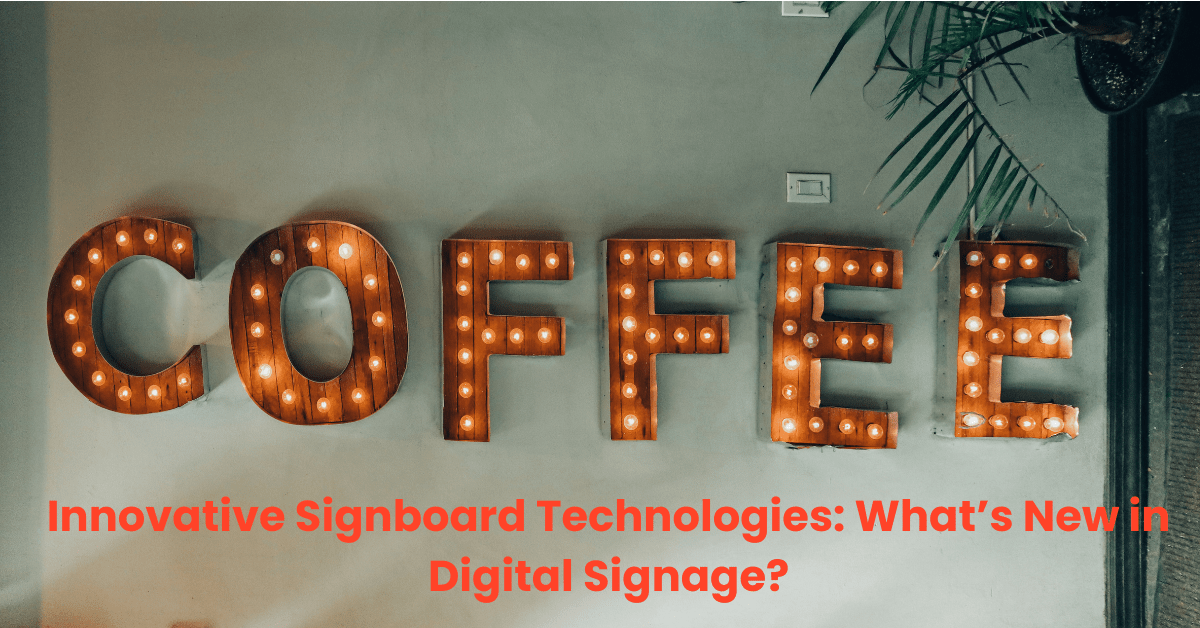Overview of Digital Signage
Digital signage refers to electronic displays used to convey information, advertisements, or promotional content. Unlike traditional static signage, digital signage uses dynamic content and interactive elements to engage viewers. This technology has transformed the way businesses communicate with their audience, offering greater flexibility and impact.
Importance of Innovation in Signboard Technologies
In a rapidly evolving digital landscape, staying updated with the latest signboard technologies is crucial for businesses seeking to enhance their visibility and customer engagement. Innovations in digital signage provide new ways to capture attention, deliver personalized experiences, and drive meaningful interactions.
2. Interactive Displays
Definition and Types
Interactive displays are digital screens that allow users to engage directly with the content. These displays can be touch-sensitive or use other input methods such as motion sensors. Common types include:
- Touchscreen Displays: Allow users to interact with content through touch, enabling functions like zooming, scrolling, and selecting options.
- Kiosks: Standalone units that provide interactive experiences, often used for self-service or information retrieval.
- Digital Whiteboards: Large touch-sensitive boards used for collaborative work and presentations.
Key Features and Benefits
Interactive displays offer several benefits:
- Enhanced Engagement: Users can interact with content, making the experience more engaging and memorable.
- Customizable Content: Content can be tailored based on user inputs, preferences, or demographics.
- Real-Time Data Collection: Interaction data can be collected and analyzed to gain insights into user behavior and preferences.
Applications in Various Industries
Interactive displays are versatile and find applications across different industries:
- Retail: Interactive displays can provide product information, promotions, and personalized recommendations.
- Education: Used for interactive learning, collaboration, and dynamic presentations.
- Healthcare: Enables patients to access information and services in waiting areas or lobbies.
Case Studies of Successful Implementations
- Retail Case Study: A major retail chain implemented touchscreen displays to offer interactive product catalogs, resulting in a 25% increase in in-store engagement.
- Education Case Study: A university adopted digital whiteboards in classrooms, enhancing student participation and collaboration.
3. LED Screens
Evolution of LED Technology
LED (Light Emitting Diode) technology has advanced significantly since its inception. Modern LED screens are brighter, more energy-efficient, and capable of displaying high-resolution content. Key developments include:
- Higher Resolution: Advances in LED technology have enabled finer pixel densities, resulting in clearer and more detailed images.
- Improved Brightness and Contrast: Enhanced LED panels offer better visibility in various lighting conditions.
Types of LED Screens
Different types of LED screens are available, each suited to specific applications:
- Indoor LED Screens: Designed for indoor environments, offering high resolution and vibrant colors.
- Outdoor LED Screens: Built to withstand outdoor conditions, these screens are weather-resistant and provide high brightness for visibility in direct sunlight.
- Flexible LED Screens: Curved or bendable screens that can be used for unique and creative installations.
Advantages of LED Screens
LED screens offer several advantages:
- High Visibility: Bright and clear displays, even in well-lit environments.
- Energy Efficiency: Lower power consumption compared to traditional lighting technologies.
- Durability: Robust construction that withstands various environmental conditions.
Best Practices for LED Screen Installation
To maximize the effectiveness of LED screens:
- Choose the Right Location: Ensure optimal visibility and accessibility.
- Consider Maintenance Needs: Plan for easy access to screens for maintenance and repairs.
- Optimize Content: Tailor content for the specific LED screen type and environment.
Real-World Examples and Success Stories
- Outdoor LED Billboard: A city implemented a large outdoor LED billboard for advertising, leading to increased local business visibility and engagement.
- Retail LED Displays: A luxury brand used high-resolution LED screens in their flagship store, enhancing the in-store experience and boosting sales.
4. Smart Signage Solutions
What is Smart Signage?
Smart signage integrates digital signage with advanced technologies to create interactive and context-aware displays. It utilizes data from various sources to deliver relevant and timely content.
Key Technologies Behind Smart Signage
- Sensors: Collect data on environmental conditions or user interactions.
- Connectivity: IoT (Internet of Things) enables seamless data exchange and integration.
- Data Analytics: Analyzes data to deliver personalized and targeted content.
Benefits of Smart Signage for Businesses
- Personalization: Content can be customized based on real-time data, enhancing relevance and engagement.
- Operational Efficiency: Automated content updates and real-time adjustments reduce manual intervention.
- Enhanced Customer Insights: Data collected through smart signage provides valuable insights into customer behaviour and preferences.
Examples of Smart Signage in Action
- Retail Example: A store uses smart signage to display personalized promotions based on customer demographics and purchase history.
- Public Transport Example: Smart signage at transit stations provides real-time updates on schedules and service disruptions, improving passenger experience.
5. Integration with Other Technologies
Combining Digital Signage with IoT
IoT integration allows digital signage to interact with other connected devices and systems. This integration enables advanced functionalities such as:
- Automated Content Updates: Content can be updated based on real-time data from other IoT devices.
- Context-Aware Displays: Screens can adjust content based on factors such as weather, location, or time of day.
The Role of AI in Enhancing Digital Signage
Artificial Intelligence (AI) enhances digital signage by enabling:
- Dynamic Content Creation: AI algorithms can generate and display content based on user interactions and preferences.
- Predictive Analytics: AI analyzes data to predict trends and optimize content strategies.
Augmented Reality (AR) and Virtual Reality (VR) in Signage
AR and VR technologies offer immersive and interactive experiences:
- AR Signage: Integrates digital content with the real world, allowing users to interact with virtual elements overlaid on physical signs.
- VR Signage: Provides fully immersive experiences for applications such as virtual tours or interactive product demonstrations.
6. Enhancing Customer Engagement
How Interactive Displays Improve Customer Interaction
Interactive displays allow users to actively engage with content, leading to:
- Increased Interaction Time: Users spend more time interacting with content, leading to higher engagement rates.
- Enhanced Learning: Interactive elements facilitate better understanding and retention of information.
The Impact of LED Screens on Visual Appeal
LED screens offer vibrant colors and high resolution, which:
- Attract Attention: Bright and dynamic displays draw attention and stand out in crowded environments.
- Enhance Brand Image: High-quality visuals reflect positively on your brand and contribute to a professional image.
Smart Signage and Personalization
Smart signage delivers personalized content based on:
- User Preferences: Tailored messages and promotions based on individual interests.
- Behavioral Data: Content that adapts to user behavior and interaction history.
Measuring the Effectiveness of Digital Signage
Evaluate the impact of digital signage through:
- Engagement Metrics: Track interaction rates, dwell times, and user feedback.
- ROI Analysis: Measure the return on investment by analyzing sales data and customer acquisition costs.
7. Future Trends in Digital Signage
Emerging Technologies to Watch
Stay updated with emerging trends such as:
- AI-Driven Signage: Advanced AI algorithms for even more personalized and dynamic content.
- 5G Integration: Faster and more reliable connectivity for real-time updates and interactions.
Predictions for the Future of Digital Signage
Anticipate future developments such as:
- Increased Interactivity: More advanced interactive elements and user experiences.
- Greater Integration: Seamless integration with other technologies and platforms.
How Businesses Can Prepare for Upcoming Innovations
- Invest in Scalable Solutions: Choose technologies that can adapt to future advancements.
- Stay Informed: Keep up with industry trends and emerging technologies to remain competitive.
Summary of Key Points
Innovative signboard technologies, including interactive displays, LED screens, and smart signage solutions, offer numerous benefits for businesses. These technologies enhance customer engagement, improve visual appeal, and provide valuable insights.
Final Thoughts on the Future of Digital Signage
The future of digital signage is bright, with continuous advancements and innovations on the horizon. By staying informed and embracing new technologies, businesses can effectively engage their audience and maintain a competitive edge.

